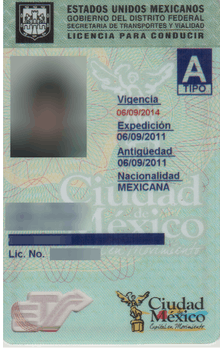Driving licence in Mexico
In Mexico, it is each state's responsibility to regulate driving in their respective jurisdiction, and therefore each state issues their own driving licence. Drivers need to demonstrate residence in a state in order to acquire that state's licence. All states recognise each other's licence.[1]

Mexican citizens and legal residents can only acquire a proper driving licence once they have turned 18, with the typical validity of a licence being 3 years.[2] Minors that are 16 or older can get a driving permit with a validity ranging from 1–6 months (depending on the jurisdiction and type of permit acquired), to 1 year.[3]
Licence Types
Generally, Mexican states follow a standardised letter-based classification on the type of driver licence and the vehicles that the bearer is permitted to drive.[4]
Minor Permit
For residents aged between 15 and 18 years old. Driving restrictions may apply, such as speed restrictions, a driving curfew, or special plates. It has a validity of 1 month, 6 months, or 1 year, depending on the state issuing the permit or the type of permit acquired. The holder can drive any vehicle intended for 'personal use', such as motorbikes (any type), or cars whose weight does not exceed 3.5 tons.
Type A
For residents 18 and older. It usually has a validity of 3 years depending on the jurisdiction. The holder can drive any vehicle intended for 'personal use', such as motorbikes (any type), or cars whose weight does not exceed 3.5 tons.
Type B
For residents 18 and older who wish to drive a taxi, with a validity of 2 or 3 years. The holder can drive a taxi as per state regulations.
Modernisation
Currently, most state governments are implementing modern licences with embedded chips. This is to avoid corruption (due to police officers having to scan the licence and input the driving offence into a special machine in order to justify the detention of someone), as well as facilitating the tracking of stolen vehicles, and providing greater security and protection from forging. Currently, the Federal District, Nuevo León, and the Estado de Mexico have implemented a chip into their licences.[5]
Testing
It is up to each individual state to determine the requirements for the acquisition of any of the aforementioned licences. For example, the Federal District considers the driving licence as a method of regulating drivers instead of certifying them, and thus issues licences without any sort of test (drivers must sign a document declaring they can drive).[6] On the other hand, the state of Zacatecas issues a written test to every new driver.[7]
References
- "Archived copy". Archived from the original on 2011-10-18. Retrieved 2011-10-28.CS1 maint: archived copy as title (link)
- "Archived copy". Archived from the original on 2011-11-07. Retrieved 2011-10-28.CS1 maint: archived copy as title (link)
- "Archived copy". Archived from the original on 2011-11-07. Retrieved 2011-10-28.CS1 maint: archived copy as title (link)
- "Archived copy". Archived from the original on 2011-11-03. Retrieved 2011-10-28.CS1 maint: archived copy as title (link)
- http://www.eluniversal.com.mx/ciudad/88049.html
- "Archived copy". Archived from the original on 2011-11-07. Retrieved 2011-10-28.CS1 maint: archived copy as title (link)
- "Archived copy" (PDF). Archived from the original (PDF) on 2012-04-25. Retrieved 2011-10-28.CS1 maint: archived copy as title (link)